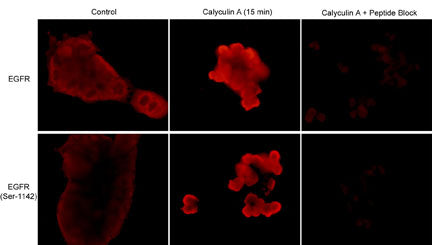Anti-EGFR (N-terminal region) Antibody
- SPECIFICATION
- CITATIONS
- PROTOCOLS
- BACKGROUND

Application
| WB |
|---|---|
| Primary Accession | P00533 |
| Reactivity | Bovine |
| Host | Rabbit |
| Clonality | Rabbit Polyclonal |
| Isotype | IgG |
| Calculated MW | 134277 Da |
| Gene ID | 1956 |
|---|---|
| Other Names | EGF, Epidermal, ErbB |
| Target/Specificity | The epidermal growth factor receptor (EGFR) is a transmembrane glycoprotein with an extracellular ligand-binding domain and a cytoplasmic domain with intrinsic tyrosine kinase activity. The cytoplasmic domain has a C-terminal region with multiple autophosphorylation sites (Tyr-992, 1068, 1086, 1148, and 1173). These sites are important for downstream signaling and rapid internalization. In addition, EGFR activation leads to c-Src mediated phosphorylation of Tyr-845 and Tyr-1101. The former site is required for mitogenic responses to EGFR activation, while the latter may be an SH2 binding site. Phosphorylation of EGFR on serine and threonine residues is thought to represent a mechanism for regulation of receptor kinase activity and internalization. These sites include a PKC site (Thr-654), CAMKII sites (Ser-1046, 1047, 1057, and 1142), and constitutively phosphorylated sites (Ser-967 and Ser-1002). Thus, the regulation of EGFR activity involves a complex series of phosphorylation events at multiple sites throughout the intracellular portion of the receptor. |
| Storage | Maintain refrigerated at 2-8°C for up to 6 months. For long term storage store at -20°C in small aliquots to prevent freeze-thaw cycles. |
| Precautions | Anti-EGFR (N-terminal region) Antibody is for research use only and not for use in diagnostic or therapeutic procedures. |
| Shipping | Blue Ice |

Thousands of laboratories across the world have published research that depended on the performance of antibodies from Abcepta to advance their research. Check out links to articles that cite our products in major peer-reviewed journals, organized by research category.
info@abcepta.com, and receive a free "I Love Antibodies" mug.
Provided below are standard protocols that you may find useful for product applications.
Background
The epidermal growth factor receptor (EGFR) is a transmembrane glycoprotein with an extracellular ligand-binding domain and a cytoplasmic domain with intrinsic tyrosine kinase activity. The cytoplasmic domain has a C-terminal region with multiple autophosphorylation sites (Tyr-992, 1068, 1086, 1148, and 1173). These sites are important for downstream signaling and rapid internalization. In addition, EGFR activation leads to c-Src mediated phosphorylation of Tyr-845 and Tyr-1101. The former site is required for mitogenic responses to EGFR activation, while the latter may be an SH2 binding site. Phosphorylation of EGFR on serine and threonine residues is thought to represent a mechanism for regulation of receptor kinase activity and internalization. These sites include a PKC site (Thr-654), CAMKII sites (Ser-1046, 1047, 1057, and 1142), and constitutively phosphorylated sites (Ser-967 and Ser-1002). Thus, the regulation of EGFR activity involves a complex series of phosphorylation events at multiple sites throughout the intracellular portion of the receptor.
If you have used an Abcepta product and would like to share how it has performed, please click on the "Submit Review" button and provide the requested information. Our staff will examine and post your review and contact you if needed.
If you have any additional inquiries please email technical services at tech@abcepta.com.













 Foundational characteristics of cancer include proliferation, angiogenesis, migration, evasion of apoptosis, and cellular immortality. Find key markers for these cellular processes and antibodies to detect them.
Foundational characteristics of cancer include proliferation, angiogenesis, migration, evasion of apoptosis, and cellular immortality. Find key markers for these cellular processes and antibodies to detect them. The SUMOplot™ Analysis Program predicts and scores sumoylation sites in your protein. SUMOylation is a post-translational modification involved in various cellular processes, such as nuclear-cytosolic transport, transcriptional regulation, apoptosis, protein stability, response to stress, and progression through the cell cycle.
The SUMOplot™ Analysis Program predicts and scores sumoylation sites in your protein. SUMOylation is a post-translational modification involved in various cellular processes, such as nuclear-cytosolic transport, transcriptional regulation, apoptosis, protein stability, response to stress, and progression through the cell cycle. The Autophagy Receptor Motif Plotter predicts and scores autophagy receptor binding sites in your protein. Identifying proteins connected to this pathway is critical to understanding the role of autophagy in physiological as well as pathological processes such as development, differentiation, neurodegenerative diseases, stress, infection, and cancer.
The Autophagy Receptor Motif Plotter predicts and scores autophagy receptor binding sites in your protein. Identifying proteins connected to this pathway is critical to understanding the role of autophagy in physiological as well as pathological processes such as development, differentiation, neurodegenerative diseases, stress, infection, and cancer.



